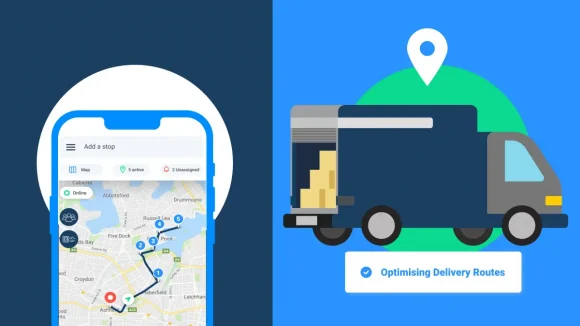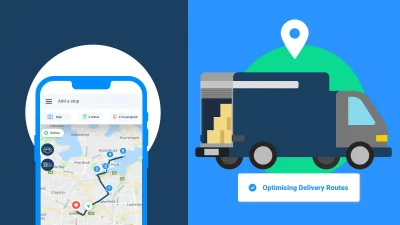In today’s business landscape, managing operational costs is more critical than ever. For fleet managers, one of the most significant expenses to consider is fuel cost. Fuel prices can fluctuate, impacting a business’s bottom line and making it challenging to manage expenses effectively. However, with the help of technology such as route planning software and the adoption of electric vehicles, businesses can save money and reduce their fuel costs.
In this article, we’ll explore various strategies businesses can use, including how to reduce fuel costs with smart delivery route planning, to lower fuel costs, improve their bottom line, and increase their overall efficiency. We’ll discuss analyzing delivery routes and schedules, improving vehicle efficiency, reducing idling time, implementing driver training programs, and investing in alternative fuels.
We’ll also touch on the importance of speed limit compliance, proper vehicle maintenance, and gas mileage tracking in fuel cost management. By implementing these strategies, businesses can reduce their fuel costs and stay competitive in today’s rapidly changing business landscape.

How to Reduce Fuel Costs with Smart Delivery Planning
Examining delivery schedules and routes
Effective delivery planning can help firms save a lot of money. Analyzing delivery routes and schedules is a crucial tactic for accomplishing this. By doing this, companies can find ways to streamline their delivery processes, lower their fuel expenses, and boost overall productivity.
Advantages of reviewing delivery schedules and routes
Analyzing delivery timetables and routes has a number of advantages, including:
Reduced fuel consumption
By planning delivery routes more efficiently, companies can shorten the distance that their vehicles must travel, which lowers fuel consumption and related expenses.
Improved delivery times
By helping businesses spend their time more effectively, routes and timetables can be improved. This can lead to faster and more dependable deliveries.
Enhanced client satisfaction
Customers that receive their products more swiftly and reliably will likely be more satisfied, which can result from more efficient delivery processes.
Utilizing technology to streamline timetables and routes
Technology advancements have made it simpler than ever for companies to optimize their delivery schedules and routes. To design the most effective routes and timetables, delivery planning software can examine a number of variables, including traffic patterns, delivery locations, and vehicle capacity. Additionally, this software may be used to track and modify routes in real-time, ensuring that deliveries are always delivered as effectively as possible.
Deliveries with real-time data
By giving businesses the most recent information on variables like traffic conditions, weather, and delivery volumes, real-time data can be utilized to enhance delivery planning. Deliveries may always be made as effectively as possible by using this data to change delivery routes and schedules on the fly. For instance, distribution planning software can automatically modify delivery routes to avoid delays and save fuel if traffic conditions change unexpectedly.
In conclusion, examining delivery schedules and routes is a useful tactic for lowering fuel expenses and enhancing delivery effectiveness. Businesses can optimize their distribution operations and realize considerable long-term cost reductions by utilizing technology and real-time data.
Increasing Car Efficiency
Businesses can increase fuel efficiency by optimizing their cars in addition to looking at delivery routes and scheduling. Driver behavior, routine vehicle maintenance, and the usage of fuel-efficient automobiles can all help achieve this.
Guidelines for enhancing vehicle effectiveness
Businesses can use the following advice to increase the fuel efficiency of their vehicles:
Reduce vehicle weight
Lighter cars require less energy to move, therefore removing unnecessary weight from them can help vehicles use less gasoline.
Maintain adequate tire pressure
It’s critical to routinely check and maintain proper tire pressure because underinflated tires might result in increased fuel consumption.
Avoid driving aggressively
Promoting safe and efficient driving practices is crucial since quick acceleration and harsh braking can considerably increase fuel consumption.
Reduce idle time
Since idle time wastes fuel and raises emissions, drivers should be urged to turn off their engines when not in use.
The significance of routine car maintenance
To ensure that vehicles run as efficiently as possible, regular vehicle maintenance is essential. This can involve routine tire rotations, oil changes, and filter replacements in addition to quick response to any problems that may emerge. In addition to increasing fuel efficiency, proper maintenance can also increase vehicle longevity and lower long-term repair costs.
Using vehicles with low fuel consumption
Finally, by investing in fuel-efficient vehicles, firms can increase the efficiency of their fleet. This can apply to cars that are electric, hybrid, or have excellent fuel efficiency ratings. Even though these vehicles may cost more up front, the money saved over time by using less fuel might make them a wise purchase.
As a result, increasing vehicle economy is a crucial tactic for lowering fuel expenses and fostering sustainability in delivery operations. Businesses can save a lot of money over time while lowering their environmental effect by adopting strategies for increasing vehicle efficiency, carrying out routine maintenance, and purchasing fuel-efficient vehicles.
Getting Rid of Idle Time
In the transportation sector, idling has a considerable impact on fuel use and emissions. As a result, businesses can save a lot of gasoline by cutting down on idle time for their cars.
Idling’s effect on fuel consumption
Idling contributes significantly to fuel consumption since it uses gasoline while doing nothing productive. The U.S. Department of Energy claims that leaving an engine idle for even 10 seconds uses more gasoline than starting it again. Idling can also shorten a vehicle’s lifespan and wear down the engine, both of which increase maintenance expenditures.
Strategies for reducing idle time
Businesses can use a variety of strategies to reduce the time that vehicles are idle, such as
- Creating rules and training drivers: Businesses may impose idling time restrictions and educate drivers about the benefits of reducing idling. For instance, while waiting at loading docks or idling for a long time, drivers may be advised to turn off their engines.
- Purchases of auxiliary power units: Auxiliary power units (APUs) can provide heating, cooling, and other necessary services without the requirement for the vehicle’s engine to be functioning. Purchases of APUs can significantly reduce idle time and associated fuel usage.
- Using shore power: Shore power enables automobiles to connect to an external power source when parked as an alternative to idling. For refrigerated trucks that must keep a constant temperature when parked, this can be especially helpful.
Utilizing technology to control and monitor idling
Technology can be utilized to keep an eye on and control delivery operations’ idle time. Telematics systems, for instance, can deliver real-time information on idle time and notify drivers and managers when excessive idling occurs. This information can be used to pinpoint regions where idling can be cut down and to put in place regulations that set time limits for idling.
Additionally, to cut down on idle time, some delivery planning software can automatically modify delivery schedules. For instance, the software can divert the truck to a nearby place if a delivery destination is closed, minimizing the length of time the vehicle is left idle.
Cutting down on idle time is a useful tactic for lowering fuel use and emissions in delivery operations. Businesses can realize considerable cost savings and advance sustainability in their operations by putting policies in place that restrict the amount of time that equipment is allowed to idle, investing in auxiliary power units or shore power, and employing technology to monitor and regulate idling.
Introducing Driver Education Programs
The achievement of fuel efficiency in delivery operations depends heavily on driver behavior. Businesses may save a lot of money on gasoline and cut emissions by encouraging fuel-efficient driving. Driver training programs are one efficient technique to encourage fuel-efficient driving.
The role of driving style in fuel efficiency
Fuel economy can be strongly impacted by driver behavior. Driving safely and effectively can reduce fuel consumption while aggressive driving, excessive idling, and speeding can all raise fuel consumption. Businesses can gain significant fuel savings and lessen their environmental effect by encouraging fuel-efficient driving practices.
Techniques to encourage fuel-efficient driving
Businesses can employ a number of tactics to encourage their employees to drive more fuel-efficiently, including:
- Providing praise and rewards: Feedback on driving style and incentives to increase fuel efficiency can be sent to drivers. Drivers who attain exceptional levels of fuel efficiency, for instance, may receive bonuses or accolades.
- Driver instruction in fuel-efficient driving methods: Driving tactics that save fuel include smooth acceleration and braking, maintaining a constant speed, and cutting down on idle time.
- Implementing performance metrics: Driver behavior related to fuel efficiency can be measured and tracked using performance metrics. For instance, measures like fuel usage per mile or idle time can be utilized to pinpoint areas where drivers should behave better.
Driver training programs’ benefits
Employing driver training programs can benefit businesses in a number of ways, such as:
- Cost savings: By promoting more fuel-efficient driving among employees, businesses can save a lot of money on fuel over time.
- Enhanced safety: Driving carefully and efficiently enhances safety, which reduces the likelihood of accidents and boosts security in delivery operations.
- Environmentally friendly practices: By cutting back on fuel usage and emissions, businesses can promote sustainability and decrease their negative effects on the environment.
In conclusion, businesses can effectively encourage fuel-efficient driving practices among their drivers by adopting driver training programs. Businesses can achieve significant fuel savings, enhance safety, and lessen their environmental effect by offering feedback, instructing drivers on fuel-efficient driving strategies, and putting performance measures into place.

How to reduce fuel costs with smart delivery planning and Locate2u
With the adoption of smart delivery route planning and the other strategies discussed in this article, businesses can take control of their fuel costs and improve their bottom line. By leveraging technology like Locate2u’s route planning software, businesses can optimize their delivery routes and schedules to minimize fuel consumption and increase efficiency.
By also focusing on improving vehicle efficiency, reducing idling time, implementing driver training programs, and investing in alternative fuels, businesses can reduce their environmental impact while saving money.
Overall, managing fuel costs is a critical aspect of fleet management, and businesses that adopt these strategies, including how to reduce fuel costs with smart delivery route planning, can stay competitive and thrive in today’s business landscape.
Visit our website to learn more!











